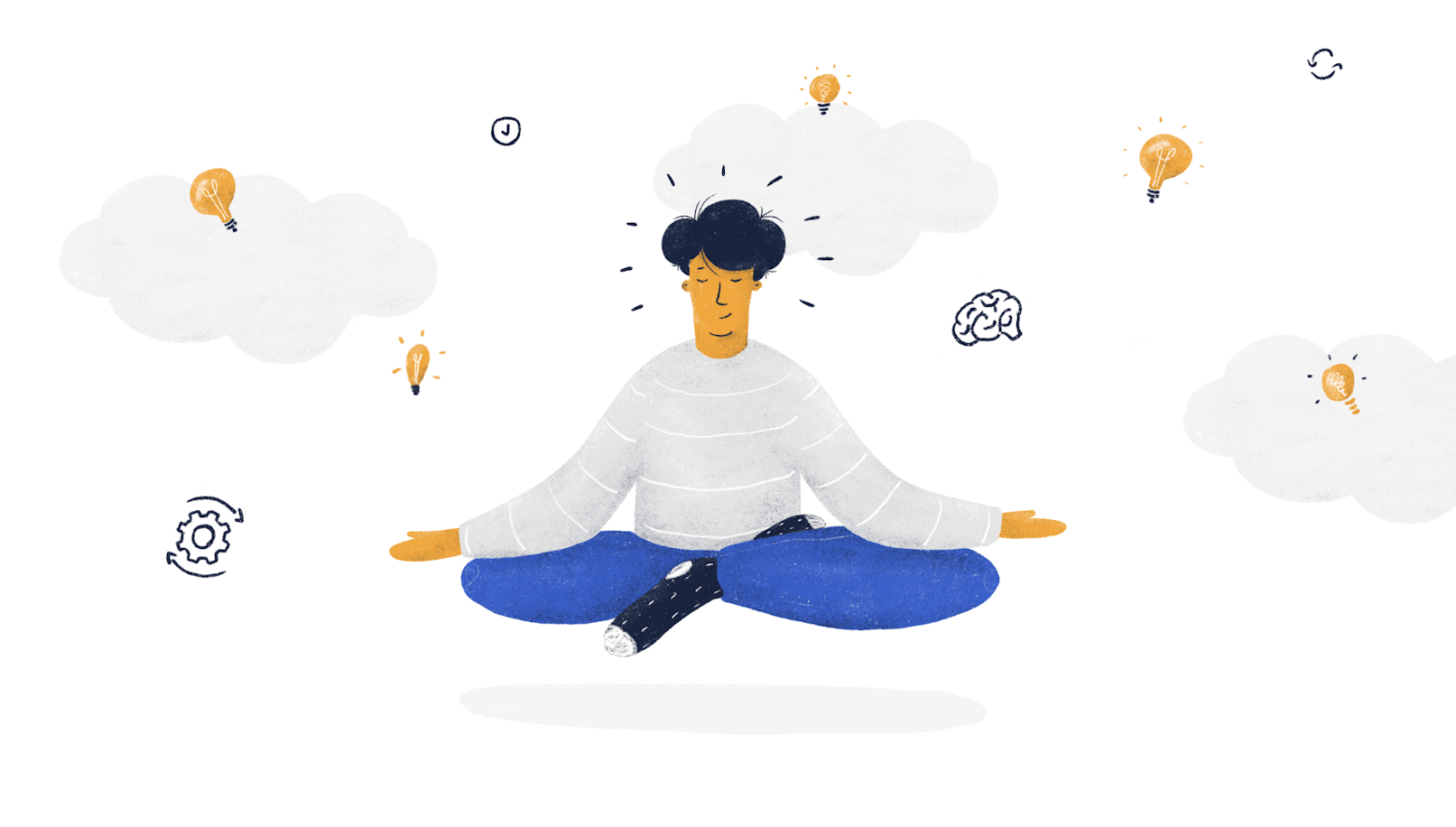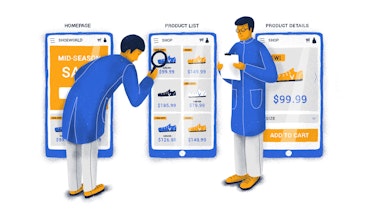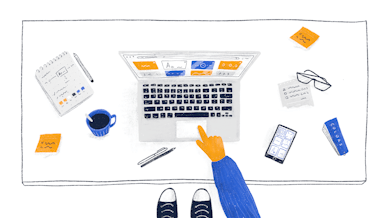Innovation is one of those modern-day mantras that we hear a lot about. It’s also one of the values that most world-renowned companies like Tesla hold dear. Is the hype justified at all? It certainly is. The fact that embracing innovation is the best long-term strategy a company can have has been a truism for quite a bit now.
On the other hand, there isn’t one single answer to how a business should implement and nurture innovation. But perhaps, that’s the whole point of innovation—being an early adopter and always being a step ahead, which leaves no time for competitors to catch up.
That’s why we’ve decided to share how we innovate within our own company and help others do the same. We’ll steer clear of the cheap motivational talk and get straight to the practical stuff.
Let’s get into it!
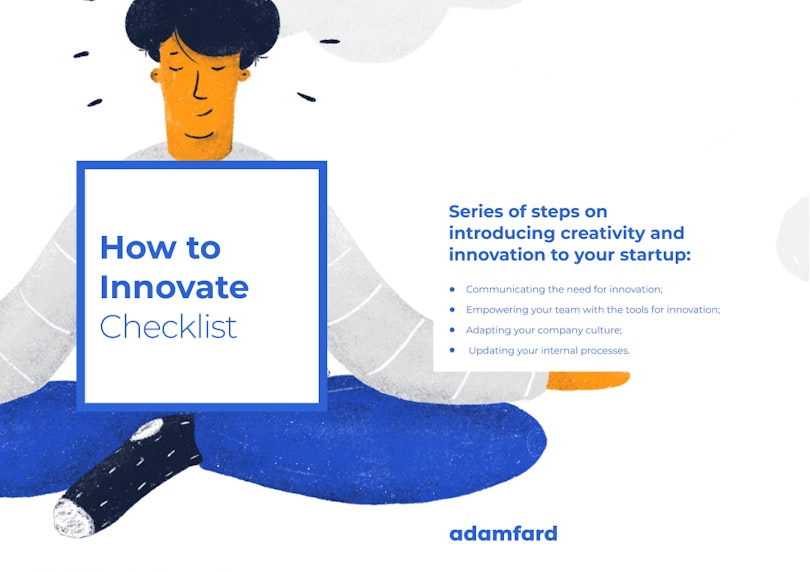
Innovation through Design Thinking
Before we proceed any further, let’s detach from the meaning of “design." While it’s in the name of the innovation framework we’d like to discuss, the truth is that design isn’t what most people think it is. It’s not something you do in Figma or Photoshop. Neither is it about visuals or aesthetics. Instead, it’s about creativity and problem-solving.
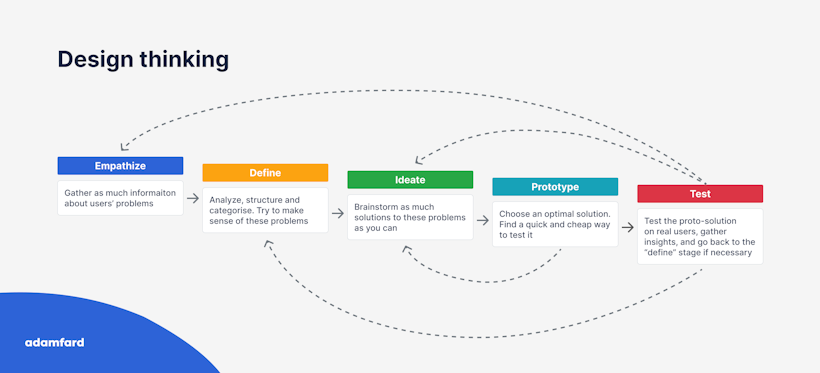
The Design Thinking framework is instrumental in solving complex issues that involve a lot of uncertainty. It focuses on tackling issues in a people-first manner by focusing on their needs. The methodology achieves that by empathizing, clearly defining problems, brainstorming, and cycling between prototyping and testing.
These five crucial stages provide for an environment that continually solves problems and innovates on any scale—product, company, and even country.
Why bother with Design Thinking or innovation?
The Design Thinking methodology is universal in many regards. It can be applied to both internal and external processes and provides a concrete structure to innovation. The framework basically tells you how to innovate in 5 steps.
However, it’s important to underline that this is a fundamentally creative approach, despite its relatively rigid structure. It enables people and organizations to experiment and think outside the box, which helps fuel both long-term and short-term strategies.
The framework doesn’t strive for perfection. It’s fundamentally open-minded and seeks to experiment and iterate to find the best solutions possible, rather than diving head-first into what seems like an ideal course of action.
Tips on integrating Design Thinking into your team
While being relatively straightforward, there are a variety of useful recommendations when it comes to integrating the methodology in your company’s problem-solving approach.
Educate the team on what Design Thinking is
Making the shift towards becoming an innovative company can take time. However, this is an essential investment if you’re looking to streamline innovation.
Like any product or idea, Design Thinking demands onboarding. An introductory meeting or call should suffice to lay the groundwork and explain how the company will tackle issues from now on.
The final form of the framework’s adoption should result in its wholehearted adoption. It’s best to let this design-first approach run through your company’s DNA and act as a guiding principle.
It’s best, however, to take small and calculated steps towards Design Thinking’s incorporation within your team’s workflow.
Create a workflow that leverages Design Thinking
Being goal-oriented is an admirable trait, but there should be a rigid system in place to establish your team’s direction. Reverse engineering Design Thinking to achieve goals that were set outside the framework is a counter-productive endeavor. Therefore, it’s essential to create a system or a series of rituals that will adapt to the Design Thinking way of thinking. Here's an example: set regular meetings to discuss areas of improvement, reflect on previous experiments and come up with new ones.
“Defining problems in obvious, conventional ways, not surprisingly, often leads to obvious, conventional solutions. Asking a more interesting question can help teams discover more original ideas. The risk is that some teams may get indefinitely hung up exploring a problem, while action-oriented managers may be too impatient to take the time to figure out what question they should be asking.”
A workflow that makes use of this methodology enables team members to have a more open-minded approach that revolves around experimentation.
Incentivize
Adoption should be a gradual and steady process. Therefore, it’s imperative to incentivize and reward your team members when they successfully take steps towards incorporating Design Thinking in their workflow. These incentives can be all sorts of things: from a pay bonus to public recognition.
Freedom to fail
The Design Thinking framework is forgiving towards mistakes since it’s an approach that favors experimenting and learning from failure—this why this methodology chooses not to chase perfection and approach problem-solving in an iterative manner. Therefore, since failure is inevitable, it's imperative that you develop an environment that cherishes mistakes.
Activities that facilitate Design Thinking
Every phase of the framework demands different activities. Empathize, Define, and Ideate extract a better understanding of users, their problems, and possible solutions to them via workshops.
There are a wide array of activities that can support and fuel prototyping. They can change and shift depending on the product or the problem you’re aiming to solve.
Testing generally revolves around user interviews. The idea here is to let people report their experience with a prototype and, subsequently, learn from it. As a result, we’ll be able to leverage these findings into improving our prototypes.
You may have noticed three out of five stages rely on workshops to fuel decision-making—but before you brush it off as a waste of time, we’d like to underline that there are many reasons to conduct them.
According to Nielsen Norman Group, UX workshops are essential when it comes to solving pressing issues and enabling progress throughout a design timeline. Workshops help teams to dedicate time to isolated and clearly defined tasks like ideation or finding actionable goals to pressing product-related issues.
Essentially, these workshops are vital for innovation, given that they are structured and conducted appropriately. Let’s take a quick look at some recommendations on conducting useful workshops.
Tips on conducting quality workshops
Workshops really start to fulfill their potential when you bring in as many participants as possible. Of course, it also gets more challenging to run a workshop smoothly with many participants, but extra perspectives are all worth it. These events can be conducted both in-person and remotely.
Typically, remote workshops require a collaborative tool for brainstorming and a video-conferencing tool. We personally use Miro and Google Meets or Zoom. It’s essential to organize the digital space so that it’s ready to use when participants join. Here’s how a prepared workspace might look:
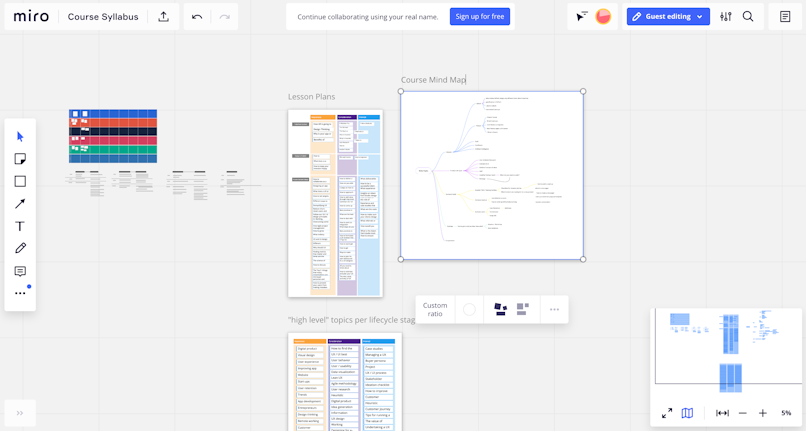
Offline workshops also require preparation. Aside from that, inventory is also something that needs to be taken into account—pens, whiteboards, sticky notes, and any other stationery.
A few protips:
Insist that participants turn on the camera so that they remain focused on the event;
Have ice-breakers before the main session, so that the participants are less stressed;
Make sure to clearly articulate the goals of the workshop. The last thing you want is people being bored and wondering what they're doing here;
Encourage people to speak up, even if some of your team members are shy. Naturally, some of the participants will be more present due to their personality traits. Make sure that this does not skew the workshop results. If bad comes to worse, and there's a tendency for just a few people to speak, you can incorporate voting, so that each voice is always heard. Alternatively, you can explicitly ask the opinions of the quiet participants.
Quantity beats quality in a good number of workshops. Make sure to discourage any premature criticism and speak your ideas freely.
More activities to explore
There is a wide array of activities and exercises that can assist teams during each phase of the Design Thinking framework. Let’s take a closer look at them.
Empathy phase
As mentioned previously, this stage is all about understanding the people whose problems you're solving. Fortunately, there is a variety of exercises we can make use of to empathize with them.
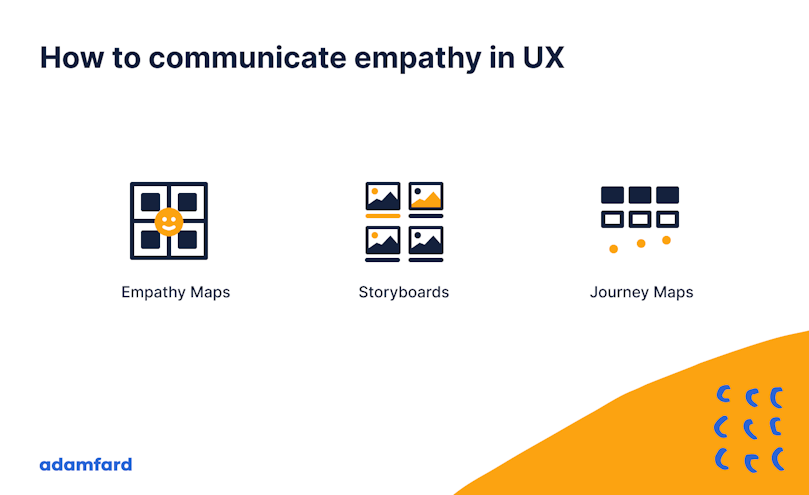
Empathy maps
Fundamentally, empathy maps are collaborative visualizations of a person’s opinions, needs, aspirations, and other facets of their outlook on life and interaction with products and services.
They are essential when it comes to creating a common understanding of the solution requirements from the stakeholders' perspectices, which will provide assistance in decision-making in further stages of the methodology.
These maps are often separated into four quadrants that describe what people, whose problems you're solving, say, think, do, and feel.
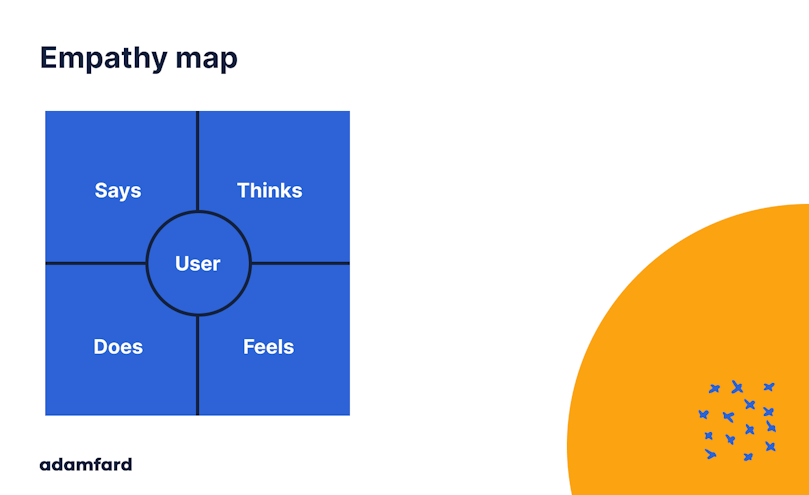
Storyboards
Storyboards are yet another technique applied during the Empathize stage that allows a team to understand a person’s experience with the solutions that it’s developing. A well-executed storyboard will guide a team towards laying the foundation of a truly helpful people-oriented prototype.
One of the great things about this technique is that it’s pretty inexpensive. It demands little time investments and is easy to execute from a technical standpoint—a pen and paper should just about do it.
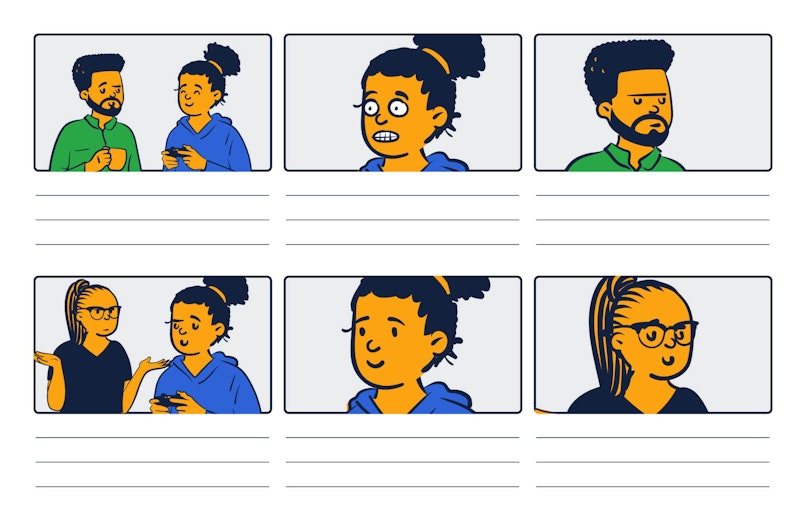
Don't mind our fancy illustration. Your drawing skills don't have to be superior to those of a 6-year-old for this activity :)
Journey mapping
User journey maps help companies understand a person’s interaction with a product throughout a variety of channels over time. Don't be misled by the word "user". This visualization approach can be applied to any sequence of actions people take.
The maps typically look like a timeline of a person's movement through a series of product/company touchpoints. The true value of the map is that it documents and visually communicates the path a person takes through a particular experience.
Additionally, a journey map can come in handy in assisting a team with tracking quantitative KPIs. As a result, it can be a very useful instrument that will fuel future strategic decisions.
Define phase
This is a stage that cycles through analysis and synthesis. The former revolves around digesting large amounts of data into smaller, bite-sized components. On the other hand, the latter focuses on piecing these ideas together to get the “big picture.” Simply put, the Define stage is all about finding patterns.
Affinity Diagramming
This is a vital tool for organizing large amounts of data and finding themes and patterns. The exercise leverages the data extracted from user research (or any other people-oriented research) and makes use of sticky notes to classify important ideas from the research data into meaningful categories.
Ideate phase
In the context of Design Thinking, ideation leverages the information collected and synthesized in the Empathize and Define stages to generate solutions to user problems. It’s important to underline that quantity comes before quality during this stage—even the most outlandish ideas should be written down and pondered upon.
This leads us to the second rule of ideation—no criticism allowed. When ideating, participants should feel safe sharing even impractical ideas, since judging them for doing so will prevent team members from sharing their input.
The 6-3-5 method
This is a fairly simple exercise: 6 people write 3 ideas in 5 minutes. Then, the participants exchange their notes and build new ideas on top of their colleagues’.
Brainstorming
While typically involving facilitators, brainstorming sessions are free-flowing. There are a few things that are important to take into account when organizing a brainstorming workshop—set time limits, have a clear problem as the topic for the session, encourage the free exchange of ideas, and allow one conversation at a time.
Crazy 8
This is a quick sketching exercise that enables team members to sketch eight different ideas or solutions in a span of eight minutes. The essence of the exercise is to stimulate creative thinking and push beyond the first idea. It allows teams to stay creative while exploring possible solutions by focusing on quantity.
Prototype and test phases
The activities for these two stages heavily depend on what problem you’re solving and your approach towards it. If you’re building a new feature, for example, you could create a clickable prototype and then have your users interact with it to gather feedback. If you’re testing a new tool, you can get a trial version first and see how it compares to the current workflow.
The philosophy of prototyping is getting the feel of the solution with minimum effort. In turn, testing is applying this prototype in a more-or-less real-world situation.
Bottom line
That was quite the ride! Let’s briefly go over the key takeaways. We’ve created a brief summary of this article that might assist you with incorporating Design Thinking as an innovation framework into your company:
Start with educating yourself and your team on what Design Thinking is;
Have a series of internal meetings with your team to explain what, why, and how design thinking works;
Educate your team on the essential Design Thinking tools, such as workshops, and how these tools should be used;
Let your team brainstorm where they can apply these tools;
Work on establishing the company culture that rewards innovation;
Consider different incentives (including financial ones) to nurture an innovative mindset and recognize success;
If necessary, reconsider your startup identity (values, vision, culture) to encourage innovation;
Update your processes
Design your processes in such a way that it allows for experimentation (Create recurring meetings to discuss problems, solutions, innovation, experiments, and their results)
Note, that a lot of these things are not order-sensitive. You can have a lot of these activities run in parallel. Additionally, Design Thinking is a framework that only works in conditions of total investment and commitment to innovation and efficient problem-solving.

